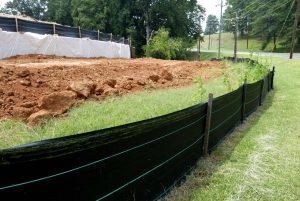
Silt fences are temporary barriers intended for retaining sediment and controlling erosion on construction sites. These fences are made out of synthetic filtration fabric, usually geo-textile filter fabric, woven together to create sheets of material that offer incredible strength and a good level of permeability. This enables water to flow through while preventing sediment from flowing downhill. Wooden or steel posts spaced at regular intervals are used to support the fabric. There are many different silt fence fabric options you can choose from, depending on your application. Your choice of sediment control material should depend on the kind of erosion, water, or sediment control that your site requires. Your standard options include but are not limited to the following:
- Standard staked silt fences – The fabrics used for standard staked silt fences fall under three grade-categories, namely economy grade, contractor grade, and DOT grade. These fabrics offer good filtration capabilities, able to contain dirt, sediment, and other displaced materials while allowing water to flow through. This effectively limits erosion.
- Wire back silt fences – Wire back silt fences are also commonly used in construction sites. Like standard staked fences, they make use of woven geo-textiles, but with the added support of a mesh wire fencing (welded or field wire), ideal for controlling stronger downhill flows.
- Orange safety fence – Another popular option on job sites, orange safety fences are ideal in areas requiring high visibility and support. These fences are made out of plastic mesh and they are typically used as perimeter or warning fences for hazardous areas and dangerous job sites.
- Higher control staked silt barrier – In areas with significant water flow, impermeable silt barriers might be a better option. Rather than a mesh fabric that enables water flow, these barriers use a high-strength material that is impermeable to water and instead controls or redirects flow as needed. They are typically built using the same materials as turbidity curtains, which allow for effective control of higher water levels as well as faster flow rates.
Many construction sites make the mistake of installing silt fences incorrectly. Silt fences are most effective when the fabric is buried along with the stakes. The fence should form an entrenchment in the ground to ensure erosion control. Periodic inspection of the installation must also be done to ensure efficiency throughout the duration of the project. Sediment build up must likewise be removed once it reaches a third to half the fence height.
